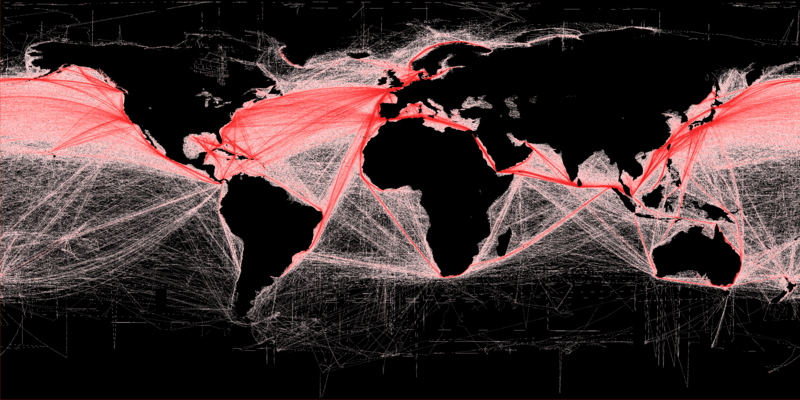The Panama Canal might be one of the most well-known waterways on the planet, but is it still the most strategic one? This is a very complex question that requires a dive into history, trade data and some speculation over geopolitical developments.
Firstly, why was the Panama Canal initially built? The idea of cutting the Isthmus of Panama was not new by the time construction started. Indeed, there has been a previous French attempt during the 1880s, but success came only when the United States stepped in. Only in 1999 control over the canal would be transferred to the country of Panama. The idea behind its construction was to cut shipment times from Europe to Asia and between the two coasts of the United States. Accordingly, the US was and remains the main user of the canal which registered its millionth passing in 2010.
This waterway has been the centre of vital trading routes for most of the 20th century and still is extremely valuable to international trade. This is further evidenced by the numerous interventions, more or less direct, that this small nation has witnessed since its inception. Especially in the early days, the interest of the United States to protect its extremely expensive project was such that military interventions were constitutionally allowed by the newly formed Republic of Panama. In fact, not shy of using this newly found power, the US conducted four bloodless military interventions between 1908 and 1925. Most notably, the country was invaded for the last time in 1989 under the Bush administration. From this point onwards Panama started a democratic transition and a series of privatizations that led, through the decades, to positive GDP growth until the recent COVID-19 pandemic.
Moreover, the Panama Canal is among the largest contributors to the State’s Treasury and its revenues have been constantly increasing. Additionally, it is forecasted, after the opening of new locks aimed at making the Canal the centre of global trade once more, that the revenues for the fiscal year 2022 will reach $4.2 billion. Thus, could we confidently affirm that this infrastructure project has been a success? Yes and no. Indeed, the Canal has successfully adapted to the new paradigm dictated by the contemporary transhipment model and the consequent need for increasingly larger cargo ships, but its use still remains tightly linked to the economic might of the United States. This has obvious implications that will be analysed in the following paragraphs, where the reasoning will fall more into the realm of possibilities.
Firstly, it must be taken into consideration that various historic processes heavily affected the composition of the US economy, thus making it a net importer running on constant trade deficits. This had repercussions over the global centre of trade and led to a reshaping of the supply chains, that became more global with the outsourcing of manufacturing to Asia. Therefore, the United States went from being the mightiest industrial power during the first decades of the Canal’s existence to a mostly debt-driven service economy. The same, to different degrees, happened to Western Europe, thus creating large manufacturing hubs abroad that mostly ship their goods towards the wealthier consumer markets of the West. The effect of this historic process has led to the shift of the centre of global trade from the Atlantic to the Pacific and Indian oceans. In the context of this transition, China has been the net gainer and its exports topped $3.5 trillion in 2021. This sum is significant, especially when taking into account the $1 trillion less of goods exported by the US for the same fiscal year. Furthermore, the deterioration of US-China relations prompted a reduction in the volume of trade between the two countries. However, this did not alter the US’s position as the largest trading partner for China. On the contrary, the value of the EU’s trade with the Asian giant has been steadily increasing; trade that mostly passes through the Suez Canal. But there is good news for the Panama Canal. In fact, the EU-US trade volume has steadily increased too and the fastest way for European goods to reach the other coast of the United States is via the Isthmus of Panama.
Secondly, serious consideration must be given to the new trading routes that are opening up in the Arctic region due to man-made climate change. Indeed, this is not only a threat to the Panama Canal, but to the Suez Canal as well. In fact, not having to pay any toll or having to pass through foreign-owned infrastructure presents many benefits to the rising international actors that are attempting to subvert the current international order. Moreover, the Northern Sea Route presents advantages in terms of shipping times if compared to the established trading routes.
Lastly, the BRI (Belt and Road Initiative) is attempting to establish sino-centric global supply chains and to penetrate economically in what has traditionally been an American-dominated area, namely Central and South America. Therefore, the Panama Canal could become an interesting hotspot for competition between the two countries. However, this could lead to either greater importance for the Canal on the world stage as well as one of the two powers seeking alternative solutions to its use.
In the face of these facts, it is difficult to draw clear-cut conclusions. Indeed, the Canal could succumb to new historical developments, but could also emerge as an increasingly strategic chokepoint once more. Paradoxically, the only certain predictable outcome is that its future will be more volatile and strictly linked to the world order that will emerge once the dust of the recent decade has settled.
Author: Marco Garzia
